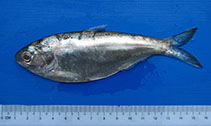http://www.fishbase.org/Summary/speciesSummary.php?genusname=Gudusia&speciesname=variegata ---> http://193.10.57.58/Summary/speciesSummary.php?genusname=Gudusia&speciesname=variegata
http://193.10.57.58/Summary/speciesSummary.php?genusname=Gudusia&speciesname=variegata ---> http://193.10.57.58/summary/Gudusia-variegata.html
Gudusia variegata, Burmese river shad : fisheries

You can
sponsor
this page
Common name (e.g. trout)
Genus + Species (e.g. Gadus morhua)
-

-
About this page
-
Languages
-
User feedbacks
-
Citation
-
Uploads
-
Related species
-


 Burmese river shad
Upload your
photos
and
videos
Burmese river shad
Upload your
photos
and
videos
Pictures
|
Google image
 Gudusia variegata
Gudusia variegata
Picture by
Win, T.
Teleostei (teleosts) >
Clupeiformes
(Herrings) >
Dorosomatidae
(Gizzard shads and sardinellas)
Etymology: More on author:
Day
.
Environment: milieu / climate zone / depth range / distribution range
Ecology
Freshwater; pelagic; amphidromous (Ref.
51243
). Subtropical; 26°N - 17°N
Asia: rivers of Myanmar (chiefly the Irrawaddy, but perhaps others).
Size / Weight / Age
Maturity: L
m
?
range ? - ? cm
Max length : 16.0 cm SL male/unsexed; (Ref.
188
)
Dorsal
spines
(total): 0;
Anal
spines
: 0. Scutes along belly, 29 or 30. Three small triangular pectoral axillary scales; depressed tip of dorsal fin not reaching to vertical from anal fin origin. Hind margin of scales toothed. Dark blotch behind gill opening, followed by a series of spots along upper flank. Gill rakers fine and numerous, increasing with size of fish (100 to 280 in specimens of 4 to 16 cm standard length).
Occurs in the middle and upper reaches of rivers. More data needed.
Life cycle and mating behavior
Maturity
|
Reproduction
|
Spawning
|
Eggs
|
Fecundity
|
Larvae
Whitehead, P.J.P.
, 1985. FAO Species Catalogue. Vol. 7. Clupeoid fishes of the world (suborder Clupeoidei). An annotated and illustrated catalogue of the herrings, sardines, pilchards, sprats, shads, anchovies and wolf-herrings. FAO Fish. Synop. 125(7/1):1-303. Rome: FAO. (Ref.
188
)
IUCN Red List Status (Ref.
130435
)
Least Concern (LC)
; Date assessed:
05 March 2018
CITES
Not Evaluated
Not Evaluated
Threat to humans
Harmless
Human uses
Fisheries: subsistence fisheries
FAO - Publication:
search
|
FishSource
|
More information
Countries
FAO areas
Ecosystems
Occurrences
Introductions
Stocks
Ecology
Diet
Food items
Food consumption
Ration
Common names
Synonyms
Metabolism
Predators
Ecotoxicology
Reproduction
Maturity
Spawning
Spawning aggregation
Fecundity
Eggs
Egg development
Age/Size
Growth
Length-weight
Length-length
Length-frequencies
Morphometrics
Morphology
Larvae
Larval dynamics
Recruitment
Abundance
BRUVS
References
Aquaculture
Aquaculture profile
Strains
Genetics
Electrophoreses
Heritability
Diseases
Processing
Nutrients
Mass conversion
Collaborators
Pictures
Stamps, Coins Misc.
Sounds
Ciguatera
Speed
Swim. type
Gill area
Otoliths
Brains
Vision
Tools
E-book
|
Field guide
|
Length-frequency wizard
|
Life-history tool
|
Point map
|
Classification Tree
|
Catch-MSY
|
Special reports
Check for Aquarium maintenance
|
Check for Species Fact Sheets
|
Check for Aquaculture Fact Sheets
Download XML
Summary page
|
Point data
|
Common names
|
Photos
Internet sources
AFORO (otoliths) |
Aquatic Commons
|
BHL
|
Cloffa
|
BOLDSystems
|
Websites from users
|
Check FishWatcher
|
CISTI
|
Catalog of Fishes
:
genus
,
species
|
DiscoverLife
|
ECOTOX
| FAO - Publication:
search
|
Faunafri
| Fishipedia |
Fishtrace
| GenBank:
genome
,
nucleotide
| GloBI |
Google Books
|
Google Scholar
|
Google
| IGFA World Record |
MitoFish
|
Otolith Atlas of Taiwan Fishes
|
PubMed
| Reef Life Survey | Socotra Atlas |
Tree of Life
| Wikipedia:
Go
,
Search
| World Records Freshwater Fishing |
Zoological Record
Estimates based on models
Phylogenetic diversity index (Ref.
82804
): PD
50
= 0.7500 [Uniqueness, from 0.5 = low to 2.0 = high].
Bayesian length-weight: a=0.00912 (0.00433 - 0.01920), b=3.04 (2.87 - 3.21), in cm total length, based on LWR estimates for this (Sub)family-body shape (Ref.
93245
).
Trophic level (Ref.
69278
): 3.1 ±0.3 se; based on size and trophs of closest relatives
Resilience (Ref.
120179
): High, minimum population doubling time less than 15 months (Preliminary K or Fecundity.).
Fishing Vulnerability (Ref.
59153
): Low vulnerability (10 of 100).
Price category (Ref.
80766
):
Low
.
Back to Search
Random Species
Back to Top
Accessed through:
Not available
FishBase mirror site :
localhost
Page last modified by :
mrius-barile
- 20 July 2016
Fatal error
: Uncaught ArgumentCountError: Too few arguments to function checkEcotox(), 1 passed in /var/www/html/summary/speciessummary.php on line 2304 and exactly 3 expected in /var/www/html/includes/speciessummary.lib.php:2579 Stack trace: #0 /var/www/html/summary/speciessummary.php(2304): checkEcotox() #1 {main} thrown in
/var/www/html/includes/speciessummary.lib.php
on line
2579
|